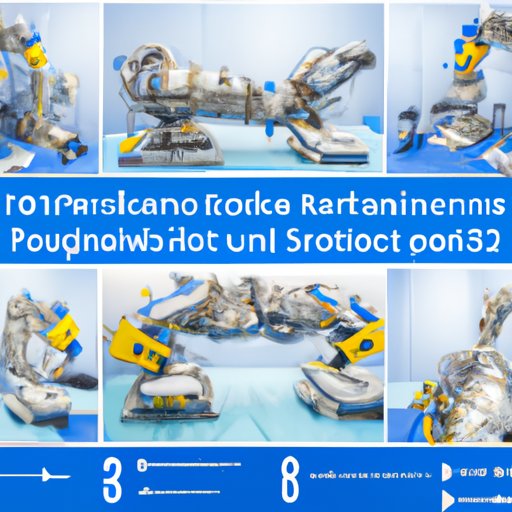Introduction
Robotic spine surgery is a minimally invasive surgical procedure that uses computer-assisted technology to assist in the diagnosis and treatment of spine-related conditions. This type of surgery is typically used to treat conditions such as spinal stenosis, herniated discs, and degenerative disc disease. Robotic spine surgery can be performed on an outpatient basis, which means that patients can typically go home the same day of the procedure.

Definition of Robotic Spine Surgery
Robotic spine surgery is a type of minimally invasive surgery that uses robotic technology to provide surgeons with a more precise view of the patient’s anatomy during the procedure. During robotic spine surgery, the surgeon will use a robotic arm to make small incisions in the patient’s back. Through these incisions, the surgeon will insert tiny instruments and a camera so they can have a better view of the area that needs to be operated on. The robotic arm then allows the surgeon to control the instruments with greater precision and accuracy than they would be able to do with their hands alone.
Overview of Benefits and Risks Associated with Robotic Spine Surgery
Robotic spine surgery has several potential benefits over traditional open spine surgery, including improved accuracy and precision, reduced blood loss, and shorter recovery times. However, there are also some potential risks associated with this type of surgery, including infection, nerve damage, and complications from anesthesia. It is important to discuss all potential risks and benefits with your doctor before having robotic spine surgery.

Latest Advances in Robotic Spine Surgery Technology
The latest advances in robotic spine surgery technology have made this type of surgery even more beneficial for patients. In addition to improved accuracy and precision, robotic spine surgery can now be used to reduce blood loss and shorten recovery times. For example, one recent study found that robotic spine surgery resulted in significantly less intraoperative blood loss compared to traditional open spine surgery.
Robotic spine surgery has also been shown to reduce the amount of time a patient needs to spend in the hospital after their procedure. Studies have shown that patients who had robotic spine surgery were able to go home sooner than those who underwent traditional open spine surgery. Additionally, robotic spine surgery may help reduce the risk of postoperative complications, such as infection or pain.

Comparing Robotic Spine Surgery to Traditional Open Spine Surgery
When considering whether to have robotic spine surgery or traditional open spine surgery, it is important to weigh the pros and cons of each procedure. On the one hand, robotic spine surgery offers several potential advantages over open spine surgery, such as improved accuracy and precision, reduced blood loss, and shorter recovery times. On the other hand, traditional open spine surgery may be necessary for certain types of spinal surgeries, such as those involving complex anatomical structures. Additionally, open spine surgery may be preferred by some patients due to its lower cost.
The decision to pursue robotic spine surgery or traditional open spine surgery should be made with the guidance of a qualified healthcare provider. Your doctor will be able to discuss the specific benefits and risks of each procedure and help you decide which option is right for you.

An Overview of the Typical Robotic Spine Surgery Procedure
Before having robotic spine surgery, it is important to understand what the procedure entails. Typically, the patient will first undergo an imaging test, such as an MRI or CT scan, to get a better view of the area that needs to be operated on. The patient will then receive general anesthesia and be positioned in a way that provides the best access for the robotic arm. During the procedure, the surgeon will use the robotic arm to make small incisions in the patient’s back and insert instruments and a camera into the area. Once the surgery is complete, the instruments and camera will be removed and the incisions closed. The entire procedure usually takes about two to three hours.
Comprehensive Guide to Finding a Qualified Robotic Spine Surgeon
When selecting a robotic spine surgeon, it is important to research different surgeons and their credentials. You should look for a surgeon who is board certified in spine surgery and has experience performing robotic spine surgery. Additionally, it is important to ask questions and seek second opinions if needed. Your doctor should be able to answer any questions you have about the procedure and the expected outcome.
Investigating Insurance Coverage for Robotic Spine Surgery
Insurance coverage for robotic spine surgery varies depending on the individual’s policy and the procedure being performed. It is important to understand your coverage and explore your options for financial assistance. Many insurance providers offer payment plans or discounts that can make robotic spine surgery more affordable. Additionally, some hospitals and clinics offer financial assistance programs for patients who need help paying for the procedure.
Conclusion
Robotic spine surgery offers many potential benefits over traditional open spine surgery, including improved accuracy and precision, reduced blood loss, and shorter recovery times. It is important to discuss all potential risks and benefits with your doctor before deciding whether to have robotic spine surgery. When selecting a robotic spine surgeon, it is important to research different surgeons and their credentials and ask questions to ensure you are getting the best care possible. Additionally, it is important to understand your insurance coverage and explore your options for financial assistance. With the right preparation and care, robotic spine surgery can be a safe and effective option for treating spine-related conditions.
(Note: Is this article not meeting your expectations? Do you have knowledge or insights to share? Unlock new opportunities and expand your reach by joining our authors team. Click Registration to join us and share your expertise with our readers.)
